Archive for the 'Fruit' Category
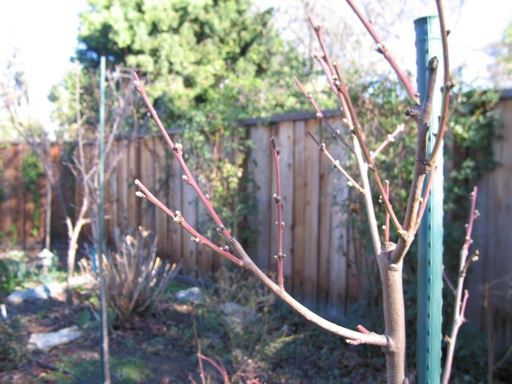
On Friday, I sprayed my peach and nectarine trees to control peach leaf curl. I also sprayed them in late December. I have been spraying my peach tree twice each winter while the tree is dormant since I planted it back in 2002.
I have heard people coming into our local nursery complaining about peach leaf curl in the spring. Unfortunately, it is too late to spray then. The spray needs to be applied at least once while the tree is dormant. I typically spray twice. In very wet years, I spray three times.
Now is the time to spray peach and nectarine trees to control the leaf curl fungus. I have read that the most important time to spray is just as the buds are beginning to swell, and before the blossoms open up. With all of the warm weather we have been having in the past month (today the high temperate neared 70 degrees again), the buds on my white nectarine tree are staring to swell (see above picture). I expect it to bloom before the end of February.
February 01 2009 | Peaches/Nectarines | Comments Off on Spraying Peach/Nectarine Trees to Prevent Leaf Curl
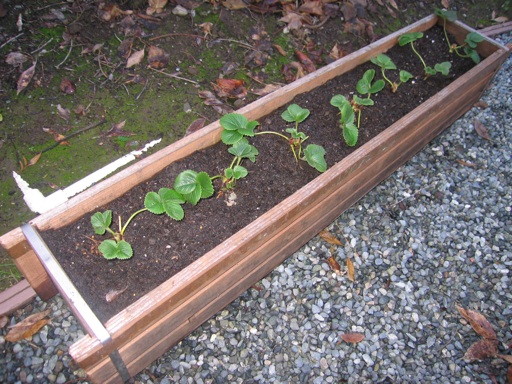
Strawberry plants proliferate by sending out runners that look like vines. The runners grow and develop roots that form new strawberry plants. Last summer, I let our strawberries send their runners into the raised beds where we grow our vegetables, because I wanted to get more strawberries for next year. The strawberries are growing in about ten pots next to the raised beds.
I spent part of the day yesterday and today transplanting most of the runner sets into pots, as in the picture above. Strawberries transplant incredibly well. I often tear off many of the roots in the transplanting process. They don’t seem to mind though. The strawberries don’t wilt or show any sign of transplant shock even after multiple transplants.
I also trimmed the new and old strawberry plants. The older plants look especially scraggly right now. They are full of dead and yellow leaves. I cut off most of the leaves of each plant, including many of the green leaves, leaving just the newly developing leaves. It seems that trimming the strawberries each winter helps stimulate them to regenerate in the spring.
After about 3 years, strawberries begin to produce fewer berries. I keep individual strawberry plants about 3-4 years before discarding them. I don’t think that growing them as annuals is the best method. In general, our strawberries have reached their peak production of berries at about 2 years from the time they rooted as runners. I don’t see the point of throwing away good plants until they are past their peak. We are growing Sequoia strawberries. Sequoia is a particularly tasty variety that grows well in California.
I am still toying with the idea of leaving some of the strawberry runners to grow in one of the raised beds. I have had a lot of success so far with growing strawberries in pots. Although, I have a tendency to plant them too close together in the pots. I keep underestimating how large they will get, so they end up looking crowded. I think I will plant just one row of them in one of the raised beds with each plant about 12 inches apart, and then judge how well they perform in 2009. Hopefully, they won’t proliferate like mad and take over the garden.
December 29 2008 | Strawberries | Comments Off on Transplanting Strawberries
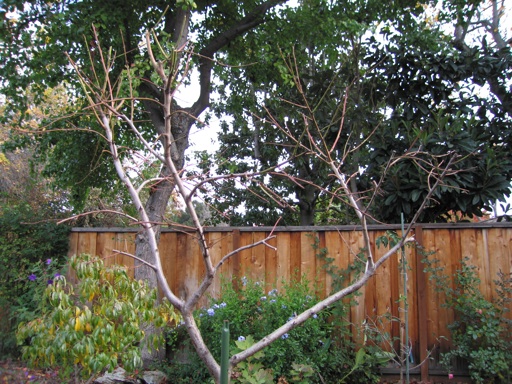
Yesterday, I pruned our peach tree. I prune our peach tree every winter to keep it small and manageable. Our tree is a small 7 year old tree. It only took about 20 minutes to prune.
Last summer, our tree grew vigorously, but some of the newly grown branches were long and weak. I trimmed those branches to prevent them from breaking next summer under the weight of the fruit.
I also cut off all of the high branches above about 10 feet, so that the tree will not develop fruit that is difficult to reach on high branches. I also cut off all of the branches that were sagging down and branches that were crossing or touching other branches. In general, I try to cut off enough branches to keep the tree in a small compact shape.
Recently, I bought a book entitled “How to Prune Fruit Trees” by R. Sanford Martin. This book provides specific details on how home growers should prune fruit trees. According to the book, different techniques should be used when pruning each particular type of fruit tree. For example, peach trees require different pruning techniques than pear trees. I didn’t know that until I read this book. I used to think that the same pruning technique could be applied to all types of fruit trees.
According to this book, ideal pruning techniques require much more attention to detail and the particular type of fruit tree being pruned. The book covers specific pruning techniques for a few dozen different varieties of fruit trees and bushes.
Peach trees develop all of their fruit on new branches that grew during the previous summer. Also, as I have discovered, peach trees tend to set a large number of small sized fruits.
Different sources suggest different techniques for forcing a peach tree to develop a small number of peaches that are large in size. Some sources advise cutting off a portion of the length of each of the new branches and twigs that grew during the previous summer. Cutting off a portion of each new branch will transfer the tree’s energy into the remaining buds, producing larger and better peaches next year. Other sources suggest entirely cutting off a large percentage (e.g, half) of the newly grown branches, while leaving the other new branches untrimmed. Of course, newly grown branches that are too long should be trimmed according to both techniques.
Last summer, our small peach tree produced over 100 small peaches. I was disappointed that the fruit was not larger, and I resolved to do something about it next year. Yesterday, I trimmed all of the newly grown branches and twigs back by about one-half in an attempt to reduce the amount of fruit production next year. I found that the newly grown branches are easy to identify, because they are thin, green and red in color, and are not woody like the older branches.
I will report back on the results next year. If our tree still produces more than about 50 fruits despite the new pruning method, I will thin them out in May.
December 08 2008 | Peaches/Nectarines | Comments Off on Peach Tree Pruning
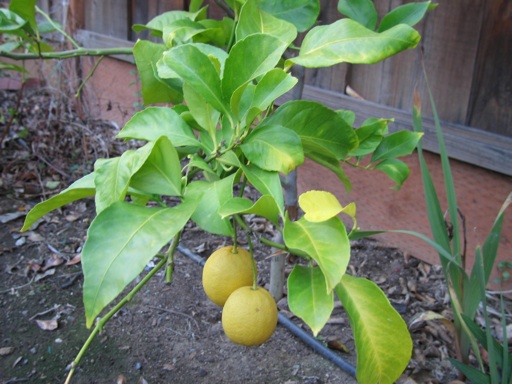
The leaves of my Eureka lemon are starting to turn yellow again, which is a classic sign of nutrient deficiency. It seems odd that the leaves are turning yellow in late fall when the plant is not growing anyway. Usually, yellow leaves appear on my citrus in the spring and summer if I haven’t fertilized them enough.
Completely yellow leaves are usually a sign of nitrogen deficiency, while green veins in the leaves with yellow in between is often caused by a lack of zinc or iron. University of Florida’s website http://edis.ifas.ufl.edu/CH142 has a good summary of the nutrient deficiencies in citrus with pictures. I’ll admit I haven’t been fertilizing it as often as I should. My guess is that nitrogen deficiency is probably the culprit. I just gave it a 10-4-10 citrus fertilizer. Hopefully, that will help.
In our area, many people grow lemon trees in their yards. Most of the lemon trees I have seen in other people’s yards are full of yellow leaves. A few of the lemon trees I have seen are completely covered with yellow leaves. Clearly, these people never bother to fertilize their lemons. Why have one then? Do they think that the leaves are supposed to be yellow just because the fruit is yellow? At least I have been fertilizing mine a few times a year.
Another problem I have had with my Eureka lemon is leaf drop. As soon as the roots get dry, it starts losing leaves. It has happened at least twice already. Last winter was unusually dry here. I stopped watering my lemon regularly, because I figured the daytime temperatures were cool enough (50s F) to prevent it from drying out. But by January, it had lost nearly all of its leaves. I have been watering it nearly everyday since then.
However, now that the daytime highs here are barely reaching above 60 again, I have cut back on watering it. But this time, I plan on continuing to water our lemon about once a week to keep the soil around it from drying out, unless of course it finally starts raining here on regular basis.
Despite all of the problems, citrus is one my favorite fruits to grow. Citrus blossoms are incredibly fragrant. And because lemon plants can produce lemons in all four seasons, one can have a supply of fresh lemons in the yard nearly all year long.
December 06 2008 | Lemons | Comments Off on Eureka Lemon Yellowing
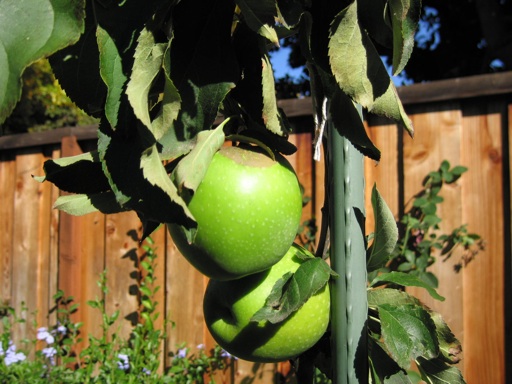
I planted a granny smith apple tree transplant in our yard in 2006. It’s a scrawny little tree. It hasn’t grown much since I planted it, even though I have been watering it regularly and fertilizing it twice a year. Even so, I have high hopes that it will undergo a growth spurt eventually.
This tree produced about 8 apples this season. The apples are large enough to cause the tree’s weak branches to sag down toward the ground. A few of the branches have broken off under the weight of just one or two apples. The tree has so few branches that some of the apples got sunburned in the summertime.
I picked granny smith partly because it has a lower chill requirement than most apples and partly because I like the flavor. The granny smith apple flavor is slightly tart, at least when it is fully ripe. People who think that granny smith apples are supposed to be extremely tart have never eaten a fully ripened one. I think that the flavor is like a very mild version of a tart green apple candy.
Some sources say that granny smith apples should be picked in September. But I have heard that they are best left on the tree until after November 1, weather permitting. Last year, I harvested them the first week of November, and they were only slightly tart. Most of them had a great flavor, although a few were bland. This year, I am leaving them on the tree a few weeks longer to see what difference, if any, a few extra weeks would make. I have harvested a few so far, and they taste about the same as last year.
November 17 2008 | Apples | Comments Off on Granny Smith Apples
« Prev - Next »




